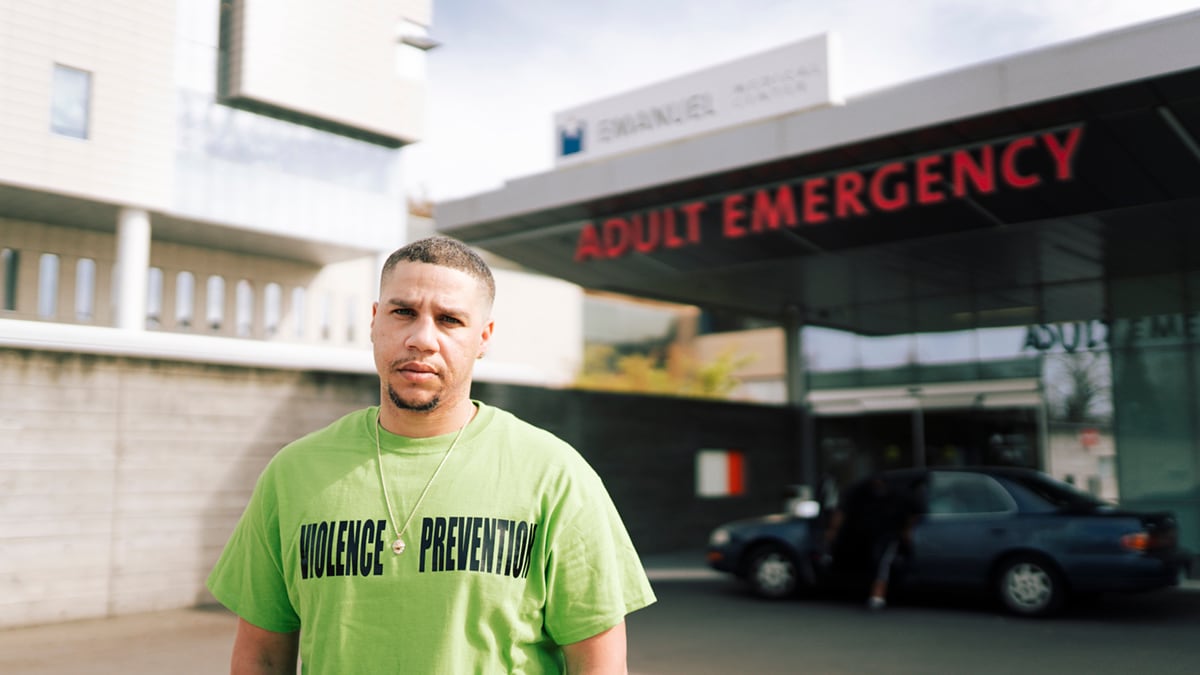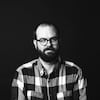On a gray afternoon last September, a road flagger working a paving job outside Portland Meadows racetrack was shot in the back. The shooter hopped out of a car, fired, then jumped back in and sped off.
The wounded man was a former gang member. Rumors on social media said the shooting was being celebrated by a rival crew. By 5:30 pm, 25 of the flagger's family and friends were waiting for news outside the emergency room of Legacy Emanuel Medical Center in North Portland.
That's when Roy Moore showed up. He was sent by City Hall as an emissary to the two dozen grief-stricken and furious people gathered in the hospital parking lot.
They couldn't go inside—COVID. They didn't know if the victim would live. People in the crowd began saying they'd settle the score.
Moore's job? Talk them out of it.
"People are crying. People are yelling," Moore recalls. "People are saying, 'I'm going to do this. I'm going to do that.' I was thinking, this could very much end badly."
Moore, 40, is a contractor on call 24/7 for the Portland Office of Violence Prevention. That office has operated in City Hall for 14 years. Working with an annual budget of $1.9 million—tiny by government standards—it is supposed to stop Portlanders from shooting each other.
Its central tactic? Contracting a squad of outreach workers whose words might sway despondent young men from pulling the trigger in street feuds.
Moore qualifies: A lifelong Black Portlander and a former gang member, he himself was shot in Las Vegas in 2005. "So I'm what you'd consider a credible messenger," he says.
Everything Moore did over the next six hours on Sept. 22 was a campaign to stop one shooting from turning into several.
Six months later, elected officials see him and his colleagues as their best hope of slowing a vicious shooting war without turning to Portland's most politically toxic solution: more cops.
Portland has never seen people killed by bullets at this rate.
The city had 18 shooting deaths in the year's first dozen weeks. Fifty-five Portlanders were killed by homicide last year, the highest number in a quarter century. At this pace, Portland will eclipse that record by August.
Nike Greene, a therapist and high school basketball coach, was hired in 2019 to run the Office of Violence Prevention. She was soon confronted by a spike in gunfire that tore through many of Portland's poorest and most diverse neighborhoods.
"People lost hope," she says. "We are a nation that has been grieving loss after loss for a year, with all gas, no brakes and no pause."
City leaders are struggling over what to do. Mayor Ted Wheeler, the police commissioner, wants to revive a police patrol unit dedicated to reducing gun violence. His four colleagues on the City Council refuse to fund it, fearing a return to police racially profiling Black people.
That places Moore in a curious spot: His work is the one strategy Portland leaders can agree on.
In the past month, both Wheeler and his colleagues have proposed a surge in funding to the Office of Violence Prevention to contract additional workers like Moore. They disagree only on how much to spend.
The mayor wants to nearly double the office's budget, adding another $1.6 million. In response, Commissioners Jo Ann Hardesty, Mingus Mapps, Carmen Rubio and Dan Ryan demand even more: a $3.5 million boost, using money Wheeler would have spent on cops.
(Update: Shortly after WW press deadlines, City Council reached a deal that sends $3.5 million to contractors doing outreach work to prevent gun violence.)
At a moment when Portland appears to be flailing, besieged by violence and bitterly divided over police, a little-known office sits under everyone's noses—and only in recent months has it gained the full attention of officials frantic for a solution. A look at the work of that office over the course of one night reveals what has gone wrong in this city, and who is best positioned to fix it.

On Sept. 22, Vanessa returned home from delivering lunch to her husband at his flagging job on North Schmeer Road. (WW has changed her name to protect her from possible reprisal.) That's when a friend called to say her husband had been shot.
In a panic, Vanessa drove to Legacy Emanuel. "I was just crying and speeding," she says. "Trying to get there."
For 45 minutes at the emergency room desk, no one would tell her his condition. That changed with the arrival of Hiag Brown.
Brown is a volunteer who works alongside Moore, who runs a program called Healing Hurt People Portland. Moore runs that program as a longtime staff member at Portland Opportunities Industrialization Center and Rosemary Anderson High School, one of the few organizations that works in street-level intervention for families impacted by violence in Portland. Its work is funded by a $349,000 grant from the Office of Violence Prevention.
Brown was able to learn what Vanessa couldn't: Her husband was stable and going into surgery.
"You could see the relief," Brown says. "Her whole body just relaxed—like, 'OK, now I can breathe.'"
Moore arrived at Legacy Emanuel shortly after. His first instinct was the same: find out the flagger's condition. "I need to know if he's going to be OK or not. I do a little prayer for whoever the victim is, because I know: That's going to determine what the night's going to look like."
When the victim got out of surgery, about an hour later, Moore was allowed to visit him. They talked about whether the flagger could change his life. About whether he felt safe. If his family needed to move.
Then Moore asked the most immediate question of the night: "Do I need to talk to some of your friends to calm them down?"
Both Moore and Brown had known the family, and many of the people waiting for news in the parking lot, for years. That's a central reason the Office of Violence Prevention contracts with them.
Many of the shootings that happen in Portland occur in a small social circle of Black Portlanders. In a 2020 analysis that studied four years of shooting data, OVP found that 50.8% of the victims and suspects in Portland shootings are Black men.
"Victims and suspects represent very similar demographics," the report concludes. "No other group is more victimized by this type of crime than African American adult males."
(In fact, the overlap is so great that on more than one night, Moore has found himself at the hospital with two groups of grieving families—only to realize that the person who shot one victim was in the hospital waiting room, worried about the fate of another victim.)
The city's grants specify that OVP is looking for outreach workers whose presence will resonate with the people most at risk of shooting someone or being shot. No one fits the bill like a former gang member who grew up in the same neighborhoods.
On the night of Sept. 22, Moore realized he needed to talk to one person in particular: the flagger's brother.
That wasn't easy. The man was in no mood to be consoled. Yet he was the person whose choices could defuse others—people would listen to him. So Moore circled back to him, hour after hour, testing his anger with small, probing questions about his family, each designed to "touch on his soft points, bring him back down to humanity."
When he learned his brother would live, the man started listening. That's when Moore made a plea: Gather up the people thinking about striking back, and let's huddle.
Moore got his audience.
He told them: "We don't need anybody else to end up here tonight. We don't need anybody to go to jail tonight. And we know that the police know there's a high potential for retaliation. You're on their radar tonight. You guys just need to lie low, give it a couple of days. I don't want to come back here for one of you guys."
That conversation offered a rare chance to connect during COVID.
The pandemic has worsened Portland's shooting wave in several ways: It robbed people of jobs, money and purpose. But it also eliminated the community gatherings where much of OVP's street outreach occurs.
"COVID took away stability," Greene says. "COVID took away the power of accountability and presence—to be able to see your uncle and your aunt on the street, and you had to think about what you did."
Filling that vacuum: social media. Much of the grief and rage after a shooting pours onto the internet. Rumors fly. Shooters brag. "People are doing shootings on Snapchat," Moore says. "Filming it, while they're on Snapchat."
Much of his work now is monitoring social media, trying to spot grudges in the form of emojis.
Isolation placed a greater burden on Moore and Brown. They're the only two people contracted to respond at a hospital—the rare place where people gather in the wake of gunfire. And they report only to Legacy Emanuel. (The mayor's funding proposal would expand the program to Oregon Health & Science University.)
Moore stayed in the hospital parking lot until 11 pm.
He spent much of the next week on the phone, soothing tempers. "I heard so-and-so is really messed up behind this," he'd say. "He needs to call me, man. I know he's stupid. I don't want to have to show up at the hospital for him."
What he didn't do: solve a crime or make an arrest. The shooter in the Sept. 22 incident is still at large.
For some observers, that's a significant gap in the city's response. Critics of the plan floated by commissioners—including the mayor—say outreach workers can't stem Portland's shooting spike without more police officers dedicated to curbing gun violence.
But evidence from other cities suggests Moore's approach is effective. Several U.S. cities, including Baltimore and San Francisco, are trying the same strategy—and early studies show steep reductions in shootings.
In Oakland, Calif., a "focused deterrence" program cut gun homicides nearly in half—from 126 to 68—in the five years after the city started it in 2012, according to the California-based Giffords Law Center to Prevent Gun Violence.
Brittany Nieto, who studies such programs at Giffords Law Center, says they can work without increased policing.
"On the law enforcement side, most of these [police departments] are probably already doing enough," she says. "You can't arrest your way out of a gun violence problem. It just doesn't work. What these strategies do is to look at why people pick up a gun in the first place."
Six months after the Sept. 22 shooting, the flagger is in physical therapy. And Moore accomplished his goal: No one else was shot that night. No retaliatory shootings are known to have happened in the weeks after.
His achievement went mostly unnoticed. The paradox of Moore's work is that when he succeeds, nothing happens.
"They'll never know the impact that we had, because nobody got shot that night," Moore says. "There was no retaliation that night. And there was a lot of people who were very, very capable of doing that. They will never know the shift in the temperature of the room. They'll never know that that's a win."

